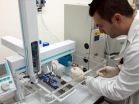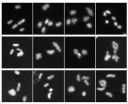(Press-News.org) Spanish and Danish researchers have developed a method for the in vivo study of the unknown metabolism of selenium, an essential element for living beings. The technique can help clarify whether or not it possesses the anti-tumour properties that have been attributed to it and yet have not been verified through clinical trials.
"It is vox populi that doctors around the world recommend selenium supplements to complement traditional therapy against cancer and the AIDS virus but the truth is that the basics of these properties are not clear," explains to SINC Justo Giner, a chemist from the University of Oviedo (Spain).
"Even the general metabolism of selenium has not been completely cleared up," adds Giner who, along with other researchers at the same university and the University of Pharmaceutical Sciences of Copenhagen (Denmark), has developed a new methodology for discovering how this element moves around living organisms. The study has been published in the March issue of the 'Analytical and Bioanalytical Chemistry' journal.
The in vivo study was carried out on laboratory rats, which were administered a stable metabolic tracer of enriched selenium (77Se). According to the researcher, "it opens the door for transferring this method to clinical trials on humans given that innocuous, non-radioactive isotopes are used."
In line with expected findings, the results reveal that selenium concentrations in biological tissue, blood and urine samples can indeed be analysed. Therefore, mass spectrometry techniques are employed along with a second isotopic tracer (74Se), which helps to quantify "with unequivocal precision" infinitesimal amounts of selenium in its different chemical forms that are distributed by the body.
Selenium is an antioxidant and plays an important role in the body's immune response. Understanding the path that it takes from the moment it is administered to when it is excreted could help to clarify its metabolism and its possible protecting effect against cancer and HIV.
The ideal dose of selenium
The main sources of selenium come from foods such as yeasts, animal products (meat, seafood, dairy products) and vegetables like broccoli, wheat-germ, nuts (especially Brazil nuts), oats, garlic and barley. The current recommended daily intake of selenium is approximately 55 micrograms for women and 70 micrograms for men.
Selenium deficiency is associated with different pathologies like endemic cardiomyopathy, cystic fibrosis, multiple sclerosis, rheumatoid arthritis, haemolysis and muscular dystrophy. Furthermore, thyroid metabolism is affected by selenium levels since the glands deiodinasa enzymes are in fact selenoproteins.
In contrast though, when intake is higher than nutritional requirements, selenium is considered a 'nutraceutical'. Mainly thanks to its antioxidant properties this means that it is beneficial for the health as long as it does not surpass the threshold in which it starts to become toxic.
INFORMATION:
References:
Kristoffer Lunøe, Justo Giner Martínez-Sierra, Bente Gammelgaard, J. Ignacio García Alonso. "Internal correction of spectral interferences and mass bias for selenium metabolism studies using enriched stable isotopes in combination with multiple linear regression". Analytical and Bioanalytical Chemistry 402 (9): 2749�, March 2012. Doi: 10.1007/s00216-012-5747-7.
Keeping track to selenium metabolism
2012-03-22
ELSE PRESS RELEASES FROM THIS DATE:
Diet may be affecting rhino reproduction
2012-03-22
Southern white rhinoceros populations, once thriving in zoos, have been showing severely reduced reproductivity among the captive-born population. San Diego Zoo Global researchers have a possible lead into why the southern white rhinoceros population in managed-care facilities is declining: phytoestrogens in their diet might be contributing to reproductive failure in the females.
"Understanding why the captive white rhinoceros population has been dwindling for decades is an important part of protecting the future of this species," said Christopher Tubbs, researcher with ...
'Obscurins' in breast tissue may help physicians predict and detect breast cancer
2012-03-22
Bethesda, MD—A new discovery published online in The FASEB Journal (http://www.fasebj.org) may lead to a new tool to help physicians assess breast cancer risk as well as diagnose the disease. In the report, researchers from Johns Hopkins University and the University of Maryland, explain how proteins, called "obscurins," once believed to only be in muscle cells, act as "tumor suppressor genes" in the breast. When their expression is lost, or their genes mutated in epithelial cells of the breast, cancer develops. It promises to tell physicians how breast cancer develops ...
Study: Low bone density medications may have protective effect on endometrial cancer
2012-03-22
DETROIT: Low bone density medications, such as Fosamax, Boniva and Actonel, may have a protective effect for endometrial cancer, according to a study at Henry Ford Hospital.
Endometrial cancer affects more than 45,000 women a year in the U.S., usually in their 60s, although it can occur before 40. A type of uterine cancer, it's the most commonly diagnosed gynecologic cancer, and there is no known preventive medication for women at high risk of developing it.
"The results of the study suggest that use of low bone density medications may have a protective effect on ...
Fleet Enterprises, LLC Awards a New Multi-Unit Franchise Agreement Latest Franchise Growth Includes Metro Areas in Indiana and Ohio
2012-03-22
Fleet Enterprises, a fleet maintenance company that provides mobile repair and maintenance services to the transportation industry, has announced that it has awarded a six-territory franchise agreement to Jerry Duda, as it continues to expand its franchise network presence throughout the Midwest region of the United States.
With rights to open operations in Indiana and Ohio, the first of the new franchised operations opened in Indianapolis in early February of this year, with two more currently underway. By the end of the year, three additional franchise locations are ...
Computer model of spread of dementia can predict future disease patterns years before they occur
2012-03-22
NEW YORK (March 21, 2012) -- Researchers at Weill Cornell Medical College have developed a computer program that has tracked the manner in which different forms of dementia spread within a human brain. They say their mathematic model can be used to predict where and approximately when an individual patient's brain will suffer from the spread, neuron to neuron, of "prion-like" toxic proteins -- a process they say underlies all forms of dementia.
Their findings, published in the March 22 issue of Neuron, could help patients and their families confirm a diagnosis of dementia ...
Holding a gun makes you think others are too, new research shows
2012-03-22
Wielding a gun increases a person's bias to see guns in the hands of others, new research from the University of Notre Dame shows.
Notre Dame Associate Professor of Psychology James Brockmole, who specializes in human cognition and how the visual world guides behavior, together with a colleague from Purdue University, conducted the study, which will appear in an upcoming issue of Journal of Experimental Psychology: Perception and Performance.
In five experiments, subjects were shown multiple images of people on a computer screen and determined whether the ...
Thromboembolic events are uncommon following ankle fracture surgery
2012-03-22
Below is a news summary of an orthopaedic research study appearing in the March 21, 2012 issue of the Journal of Bone and Joint Surgery (JBJS), as well as the issues' full Table of Contents.
Thromboembolic Events are Uncommon Following Ankle Fracture Surgery
Thromboembolic events – such as deep vein thrombosis (DVT), blood clots developing in the extremities; or pulmonary embolism (PE), a complication that causes a blood clot to move to the lungs – can occur following musculoskeletal injury and related surgery, and are potentially life threatening. In "The Incidence ...
BUSM study demonstrates tomosynthesis effective in diagnosing knee osteoarthritis
2012-03-22
(Boston) - A recent study done by researchers at Boston University School of Medicine (BUSM) shows that tomosynthesis may be more beneficial in diagnosing knee osteoarthritis than X-ray imaging. In the study, which is published online in the journal Radiology, tomosynthesis detected more osteophytes (abnormal bony spurs) and subchondral cysts (small collection of fluid within the bone) in the knee joint than conventional X-ray imaging
.
Daichi Hayashi, MD, PhD, research instructor at the Quantitative Imaging Center in the department of radiology at BUSM, is the lead ...
AmeriCheckUSA, One of the Most Trusted Names in the Background Screening Industry, Offers Competitive Pricing and Incomparable Service
2012-03-22
AmeriCheckUSA, specializing in employment and residential background checks has become one of the most trusted names in the background screening industry. Located in south Florida, AmeriCheckUSA is a full-service, licensed and insured agency with services throughout the entire United States and more than 200 countries. Part of what makes AmeriCheckUSA stand out from the competition is the company's extensive experience - more than 15 years experience in the industry, along with:
- its competitive pricing, including no set-up fees, no contracts and no monthly minimums, ...
Salk scientists open new window into how cancers override cellular growth controls
2012-03-22
LA JOLLA, CA----Rapidly dividing cancer cells are skilled at patching up damage that would stop normal cells in their tracks, including wear and tear of telomeres, the protective caps at the end of each chromosome.
Loss of telomeres forces cells out of the dividing game and into a growth arrest state called "senescence," but cancer cells evade this by employing an enzyme called telomerase to extend eroded telomeres.
If telomerase fails to activate, the tumor cells of about 10 percent of all human cancers have a back-up strategy to build serviceable telomeres and keep ...


